Diagnosis and Management of Primary Dysmenorrhea
Primary dysmenorrhea is a prevalent, underdiagnosed, but treatable condition.
View as PDF
Primary dysmenorrhea is defined as painful menstruation in the absence of an identifiable cause. Characterized by recurrent, crampy lower abdominal pain occurring during menstruation, dysmenorrhea is the most common gynecologic complaint and affects 50% to 90% of women.1
For half of women, the pain experienced is at least moderate to severe.1 Secondary dysmenorrhea refers to the same clinical features of pain during menstruation but is attributable to pelvic pathologies such as endometriosis, fibroids, adenomyosis, and congenital anatomic abnormalities (Figure 1). The management of primary dysmenorrhea is directed toward diagnosing other causes of symptoms and identifying medical therapies that satisfactorily control the patient’s symptoms.
Figure 1. Secondary Dysmenorrhea
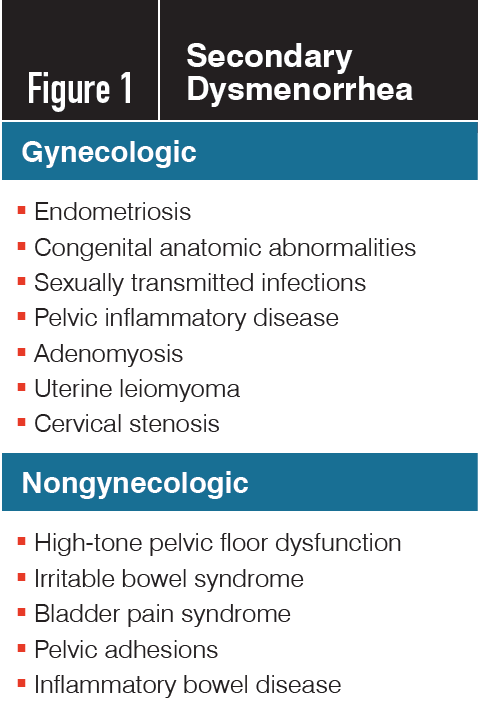
Despite its high prevalence, dysmenorrhea is often underdiagnosed, inadequately treated, and normalized even by patients themselves, who may accept the symptoms as an inevitable response to menstruation. This frequent normalization and minimization of menstrual pain leads many patients to dismiss their own symptoms and can lead to the assumption that treatment is neither warranted nor available.
All clinicians, and specifically gynecologists, should proactively inquire about the impact of menstrual-related symptoms on quality of life.
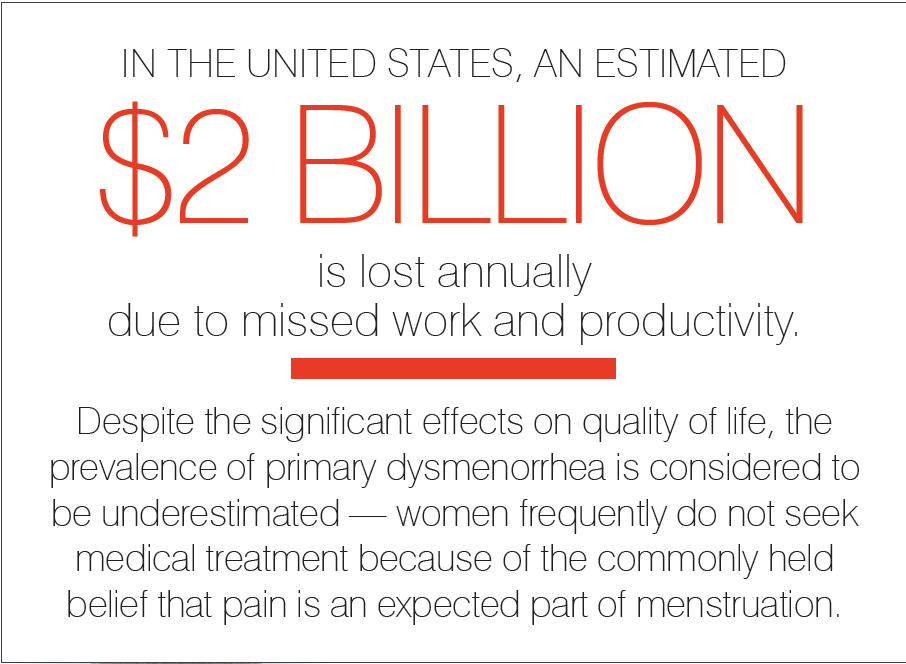
Primary dysmenorrhea generally begins in adolescence, once ovulatory cycles are established. The associated pain arises from the release of excess prostanoids, including prostaglandins at the time of endometrial sloughing. Prostanoids are derived from the cyclooxygenase pathway, which is initiated by phospholipase A2. This enzyme is released when the destabilization and breakdown of cellular lysosomes occurs as a result of declining progesterone levels at the end of the luteal phase.2 High levels of progesterone, as occur after ovulation, stabilize these lysosomes. The rise and fall of progesterone, as controlled by ovulation, and its influence on phospholipase A2 explains why primary dysmenorrhea does not occur at the very beginning of menarche, when cycles are anovulatory.3
Compared with asymptomatic women, those with dysmenorrhea have higher levels of prostaglandins in endometrial tissue and menstrual fluid.4 The increased level of prostaglandins at the time of menstruation is theorized to cause myometrial hypercontractility, resulting in hypoxia and ischemia of uterine muscle and the perception of pain, as well as systemic symptoms often associated with dysmenorrhea such as nausea and diarrhea.5
The physical, social, emotional, and economic impact of dysmenorrhea is substantial. A population-based survey of women older than 18 years with primary dysmenorrhea reported that more than half described symptoms that limited their activities and 17% missed school or work as a result.6 Dysmenorrhea is the most common cause of short-term absence from school in adolescent girls, and 1 in 8 adolescents and women aged 14 to 20 report missing school or work as a result of the condition.1
Other cross-sectional studies including thousands of women worldwide have demonstrated similar findings of primary dysmenorrhea that affect relationships, functioning, and productivity, and contribute to absenteeism.5 In the United States, an estimated $2 billion is lost annually due to missed work and productivity.7 Despite the significant effects on quality of life, the prevalence of primary dysmenorrhea is considered to be underestimated — women frequently do not seek medical treatment because of the commonly held belief that pain is an expected part of menstruation.
Diagnosis
Evaluating and diagnosing primary dysmenorrhea (Figure 2) does not require specialization in women’s health or pelvic pain, and initial complaints frequently are presented to pediatricians and primary care physicians.
Figure 2. Diagnosis of Dysmenorrhea
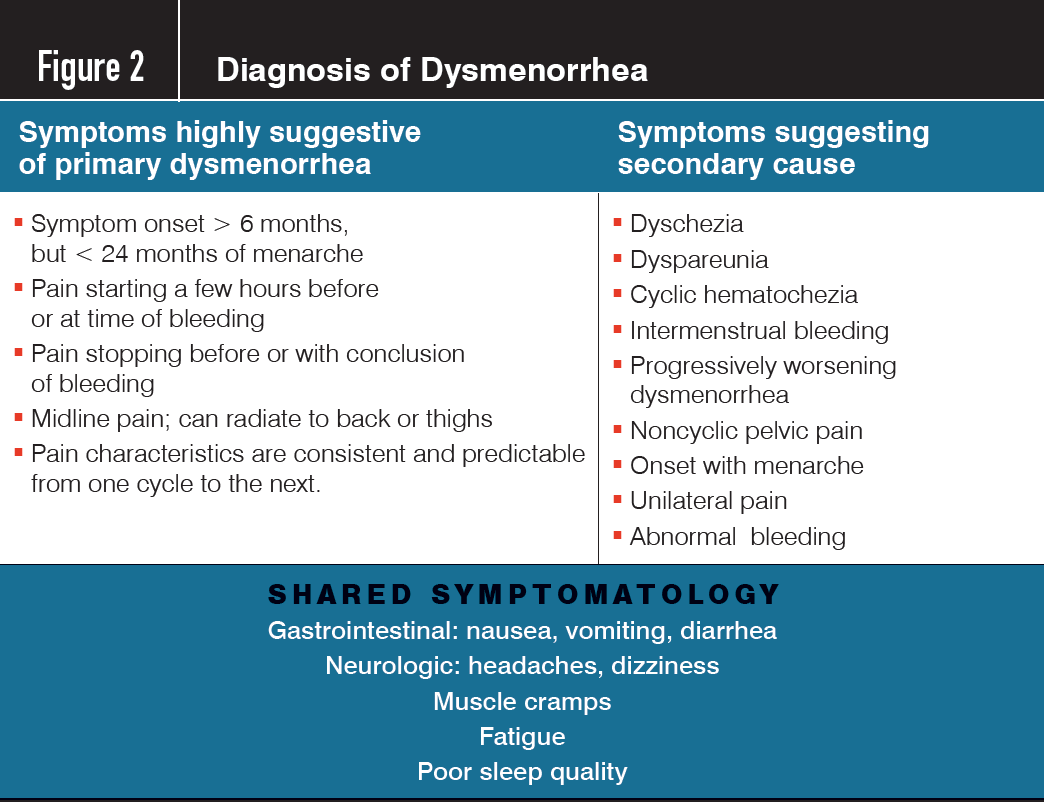
Gynecologists serve an important role in raising awareness of the condition and are a resource for treatment options and further evaluation if empiric therapy fails. A diagnosis can often be reached by obtaining a detailed medical, family, psychosocial, and gynecologic (including menstrual and sexual) history.1,2
A complete menstrual history includes age at menarche, duration of bleeding, intervals between menses, and assessment of menstrual flow; associated symptoms such as pain, nausea, diarrhea, and fatigue; and the timing of onset, severity of pain, and effect on daily activities. The onset of primary dysmenorrhea typically begins 6 to 24 months after menarche.2 Pelvic pain that starts with menarche, or quickly thereafter, may be associated with obstructive genital tract malformations and should prompt further evaluation.8 Pain is primarily midline and is often described as cramping in the lower abdomen or suprapubic region.
Patients may describe pain that radiates around the abdomen and into the lumbar area or along the anterior or medial thigh. Persistent unilateral symptoms may suggest anatomic abnormalities as the cause of pain.
Generally, symptoms begin a few hours before or after menstrual blood flow, peak at the time of heaviest blood flow, and resolve on cycle day 2 or 3. The timing, quality, duration, and location of pain associated with primary dysmenorrhea is consistent from one menstrual cycle to the next and does not progressively worsen with time. Progressive worsening or pain that persists after menses concludes is not characteristic of primary dysmenorrhea and may be related to endometriosis and other secondary causes.
Symptoms frequently associated with dysmenorrhea include nausea, vomiting, diarrhea, headaches, muscle cramps, and poor sleep quality, though these can also be found with secondary causes such as endometriosis.1,2 Additional patient factors that suggest secondary causes of dysmenorrhea include mid-cycle or acyclic pain, abnormal uterine bleeding, and infertility.
A pelvic examination is recommended in adult women presenting for the first time with dysmenorrhea because the likelihood of secondary causes is much higher in this population.
However, a pelvic exam is not necessary in non–sexually active patients — specifically adolescents — if the elicited history is descriptive of primary dysmenorrhea, and in the absence of other symptoms such as infection or abnormal bleeding.1 The pelvic exam should be normal in patients with primary dysmenorrhea when not menstruating.
Localized pain or physical findings such as uterine enlargement, pelvic mass, displacement or deviation of the cervix, nodularity in the rectovaginal septum, or uterine or cervical tenderness not associated with menstruation point to secondary causes. Sexually transmitted infections should be ruled out with appropriate testing as a potential cause of dysmenorrhea in all sexually active patients.
Transvaginal ultrasonography is the preferred method for the initial evaluation of pelvic organs. In non–sexually active adolescents and young women, transabdominal pelvic ultrasound is preferable to accommodate patient comfort. Dysmenorrhea associated with adnexal pathology or uterine abnormalities (such as leiomyoma, adenomyosis, and some Müllerian anomalies) can be diagnosed with ultrasound.
Although endometriosis is a common cause of secondary dysmenorrhea, routine pelvic ultrasound is frequently unremarkable in affected patients unless there is anatomic distortion, endometrioma, or evidence of deep infiltrative endometriosis.9 Advances in imaging have enabled clinicians to better evaluate deep infiltrating endometriosis on pelvic MRI, but this modality is not generally recommended as an initial step in evaluating dysmenorrhea unless clinical presentation suggests a secondary cause.
Treatment
Delays in diagnosis and treatment are common and should be avoided. The goals of treatment are to provide satisfactory pain and symptom relief and reduce the disturbance in daily activities.
Adolescents and young women who are not sexually active and report history and symptoms typical for primary dysmenorrhea should be started on empiric treatment without necessitating the completion of a pelvic exam or radiologic studies. However, if symptoms persist despite treatment for 3 months, further evaluation with an exam and imaging are warranted to evaluate for secondary causes. Adult patients whose history indicates primary dysmenorrhea and in whom pelvic exam findings are negative and infectious diseases have been ruled out can also be offered empiric therapy prior to further investigation with imaging.
Therapeutic options should take into account a patient’s contraceptive needs, as both nonsteroidal anti-inflammatory drugs (NSAIDs) and hormonal contraceptives are considered first-line agents, either separately or in combination. Hormonal contraceptives effective in the treatment of dysmenorrhea include combined oral contraceptive (COC) pills, the vaginal ring, and the transdermal patch. Long-acting reversible contraceptives (LARCs) such as levonorgestrel-releasing intrauterine devices (LNG-IUDs) and etonogestrel-releasing implantable rods are also effective. NSAIDs effectively treat dysmenorrhea by decreasing prostaglandin levels via the inhibition of cyclo-oxygenase–mediated production.5
Randomized, placebo-controlled trials support the efficacy of NSAIDs in the treatment of primary dysmenorrhea.5,10 However, there is limited evidence suggesting that one NSAID is more effective than another.1,2 OTC options, such as naproxen and ibuprofen, are easily accessible and affordable for most patients.
Specific instructions on optimal dosage, frequency, and duration of cyclic NSAID use should be given to patients. This is especially important for the adolescent population, in which underdosing and subtherapeutic treatment is common and thereby can lead to what is perceived to be treatment failure.8 Therapy should be initiated at symptom or bleeding onset, dosed on a scheduled basis, and continued until cycle day 2 or 38; for moderate to severe pain, therapy can be started 1 to 2 days before symptom onset1 (Figure 3).
It should be noted that 18% of patients with no apparent secondary etiologies for dysmenorrhea are resistant to NSAID therapy despite adherence to recommended treatment regimens.11
Figure 3. Treatment Recommendations
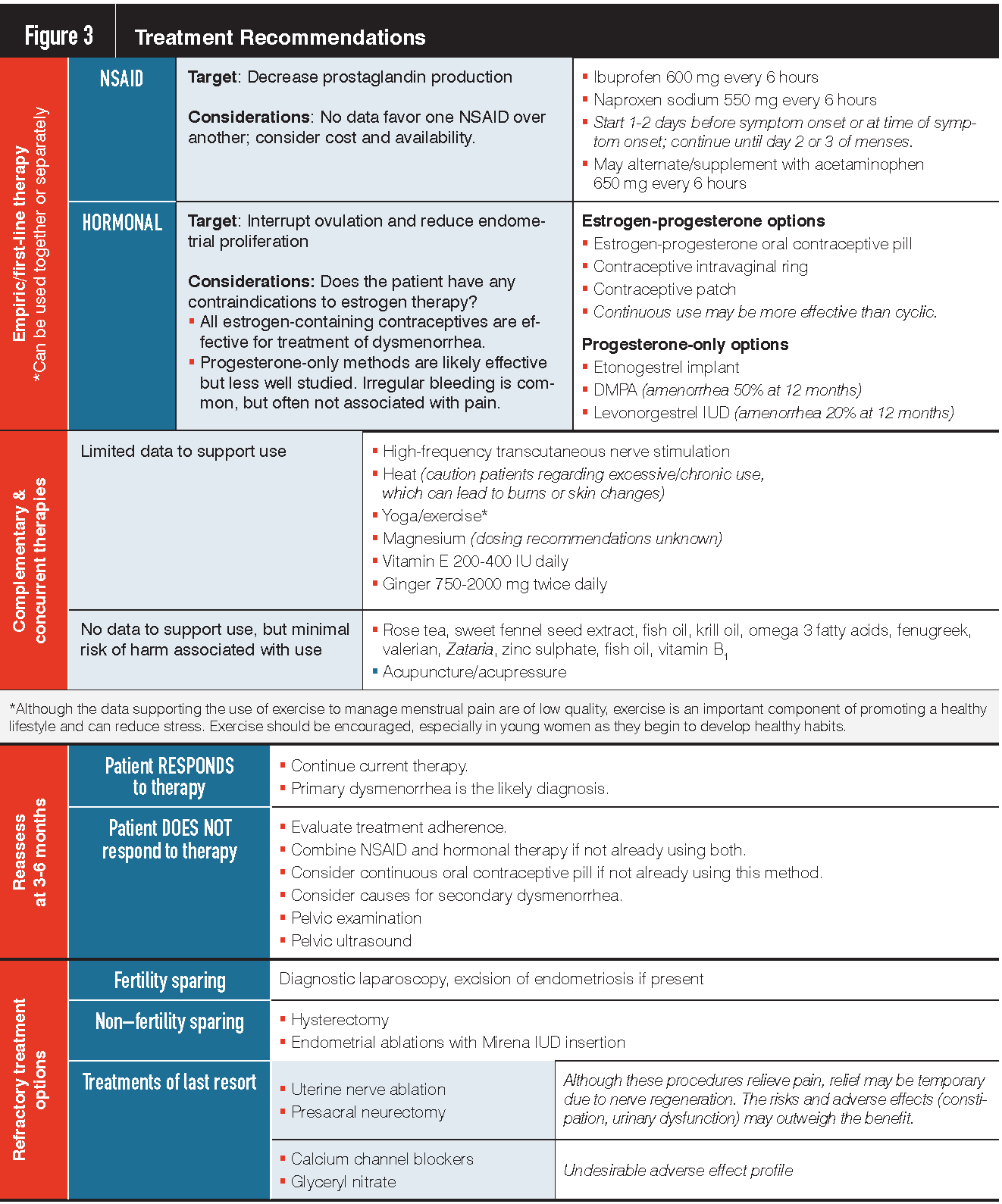
The most widely studied hormonal agents, estrogen-progestin COCs, inhibit proliferation of the endometrial lining, thereby decreasing prostaglandin production within the uterus.1 They have been demonstrated as effective in treating dysmenorrhea in several randomized controlled trials.1,8
Relief of symptoms has been shown with all formulations of COCs, including low-dose pills (20 µg ethinyl estradiol). Progestin-only methods, LNG-IUDs, and implantable rods have also demonstrated efficacy in reducing dysmenorrhea1; even adolescents and women who have never been sexually active should consider these LARCs. Continuous norethindrone acetate 5 mg is equally effective to COC, but is not approved for contraception in the United States.1
Patients are encouraged to continue first-line therapy for 3 to 6 months, and their response to therapy should be monitored 2 to 3 months after its initiation. If adequate relief of symptoms is not achieved, further evaluation or referral to gynecologic specialists is recommended. Notably, up to 70% of adolescents who fail initial therapy will have endometriosis, and this prevalent condition should remain on the differential diagnosis if symptoms progress or are suboptimally controlled with empiric therapy.8
Alternative therapies, such as heat, exercise, and dietary and behavioral interventions, are frequently employed by patients. Most therapies are low risk and may provide individual patients with improved symptom control.
Promising data, though limited, support the use of exercise,12 and high-frequency transcutaneous electrical nerve stimulation and topical heat have demonstrated the most favorable results.1,8, Limited and contradictory data exist regarding the efficacy of dietary modifications and herbal supplements in the treatment of dysmenorrhea.13 These alternatives may be useful as adjunctive therapies or in patients who are unable to take or are disinterested in pharmacologic treatments.
Nerve transection procedures such as laparoscopic uterine nerve ablation and presacral neurectomy may be considered in patients not treated with the therapies above, and in whom other secondary causes are not identified. However, there is insufficient evidence to recommend their use for primary dysmenorrhea, and the potential benefits must be weighed against the risks.
Endometrial ablation does improve dysmenorrhea associated with heavy menstrual bleeding in women no longer desiring future fertility. In a retrospective study of 144 patients, up to 50% reported resolution of menstrual pain when menstrual flow was diminished by ablation.14 Finally, hysterectomy may be considered in patients who have completed childbearing or who do not desire uterine preservation and have had an inadequate response to other therapies.
Further Evaluation
Although the majority of women will improve with these first-line medical therapies, particularly if amenorrhea is achieved, those who do not improve warrant further evaluation. Scheduled follow-up after initial treatment is important to avoid delays in diagnosis as many patients seeking attention for dysmenorrhea will have already experienced diagnostic and treatment delays.
Frequently, concurrent diagnoses of various sources of pelvic pain such as vulvodynia, pelvic floor dysfunction, and painful bladder syndrome can occur along with dysmenorrhea. Endometriosis should be high on the differential diagnosis even during the initial evaluation, regardless of patient age. If a 3- to 6– month trial of empiric medical management does not control symptoms and evaluation does not suggest other causes, such as congenital anomaly or infection, laparoscopy with a plan for concurrent surgical management should be pursued.
Endometriotic lesions may not present as classical “powder burn” lesions, especially in younger women, and surgeons offering diagnostic laparoscopy should be trained and equipped to diagnose atypical lesions and resect abnormal appearing tissue for both pathologic diagnosis and therapeutic ends.
Future Directions
As with other “benign” gynecologic conditions, despite the high prevalence of primary dysmenorrhea, research funding has been limited. Early studies implicate prostanoids as an underlying mechanism, yet there is still much to be understood mechanistically. NSAID therapy fails to satisfactorily improve menstrual pain in 18% of women,11 suggesting that prostanoids may not account for all symptomatology.
Primary dysmenorrhea is a chronic pain condition and, as seen in similar pain conditions (eg, irritable bowel syndrome, bladder pain syndrome, fibromyalgia), the processing of stimuli via the peripheral and central nervous system is altered.5 Findings from several neuroimaging studies have demonstrated differences in metabolic activity in areas of the brain related to pain perception15 and in the cerebral structure in key brain regions16 in women with dysmenorrhea compared with controls. These central changes may underlie the findings by Hellman et al in which they observed that one-fifth of patients with moderate to severe dysmenorrhea also demonstrated hypersensitivity to passive bladder filling despite no prior complaint of bladder pain syndrome.17
Whether these functional MRI findings represent cause or effect of primary dysmenorrhea has yet to be determined, but they offer opportunities for translational research and the potential for targeted therapy.
Conclusions
Primary dysmenorrhea is a prevalent, underdiagnosed, but treatable condition. Unfortunately, normalization of the association between menstrual cycles and pain leads to delays in evaluation and diagnosis for women of all ages. Inquiry into the severity of symptoms frequently reveals a significant negative impact on quality of life with potentially far-reaching consequences.
Gynecologists play an important role in building patient and community awareness of the condition, and in its diagnosis and management. Progressive worsening of symptoms or suboptimal symptom control with first-line agents warrants further evaluation for secondary causes, including endometriosis. Women with menstrual pain should not be dismissed and their symptoms should not be considered inevitable and thereby acceptable.
References
ACOG Committee Opinion No. 760: Dysmenorrhea and endometriosis in the adolescent.Obstet Gynecol. 2018;132(6):e249-e258. doi:10.1097/AOG.0000000000002978
2.Dawood MY. Primary dysmenorrhea: advances in pathogenesis and management. Obstet Gynecol. 2006;108(2):428-441. doi:10.1097/01.AOG.0000230214.26638.0c
3.Ferries-Rowe E, Corey E, Archer JS. Primary dysmenorrhea: diagnosis and therapy. Obstet Gynecol. 2020;136(5):1047-1058.
4.Chan, W.Y. and J.C. Hill, Determination of menstrual prostaglandin levels in non-dysmenorrheic and dysmenorrheic subjects. Prostaglandins, 1978. 15(2): p. 365-75.
5.Iacovides, S., I. Avidon, and F.C. Baker, What we know about primary dysmenorrhea today: a critical review. Hum Reprod Update, 2015. 21(6): p. 762-78.
6.Burnett, M.A., et al., Prevalence of primary dysmenorrhea in Canada. J Obstet Gynaecol Can, 2005. 27(8): p. 765-70.
7.Dawood, YM., Dysmenorrhea, Glob Libr Womens Med Website. Published 2008. https://www.glowm.com/section-view/heading/Dysmenorrhea/item/9#.YHevoBNKjOQ Accessed: 4/15/2021.
8.Burnett, M. and M. Lemyre, No. 345-Primary Dysmenorrhea Consensus Guideline. J Obstet Gynaecol Can, 2017. 39(7): p. 585-595.
9.Nisenblat, V., et al., Imaging modalities for the non-invasive diagnosis of endometriosis. Cochrane Database Syst Rev, 2016. 2: p. CD009591.
10.Marjoribanks, J., et al., Nonsteroidal anti-inflammatory drugs for dysmenorrhoea. Cochrane Database Syst Rev, 2010(1): p. CD001751.
11.Owen, P.R., Prostaglandin synthetase inhibitors in the treatment of primary dysmenorrhea. Outcome trials reviewed. Am J Obstet Gynecol, 1984. 148(1): p. 96-103.
12.Armour, M., et al., Exercise for dysmenorrhoea. Cochrane Database Syst Rev, 2019. 9: p. CD004142.
13.Pattanittum, P., et al., Dietary supplements for dysmenorrhoea. Cochrane Database Syst Rev, 2016. 3:CD002124.
14.Wyatt SN, et al. Effect of Radiofrequency Endometrial Ablation on Dysmenorrhea. J Minim Invasive Gynecol. 2016;23(7):1163-1166.
15.Tu, C.H., et al., Abnormal cerebral metabolism during menstrual pain in primary dysmenorrhea. Neuroimage, 2009. 47(1): p. 28-35.
16.Tu CH, et al. Brain morphological changes associated with cyclic menstrual pain. Pain, 2010. 150(3): p. 462-468.
17.Hellman KM, et al. Dysmenorrhea subtypes exhibit differential quantitative sensory assessment profiles. Pain. 2020. 161(6):1227-1236.
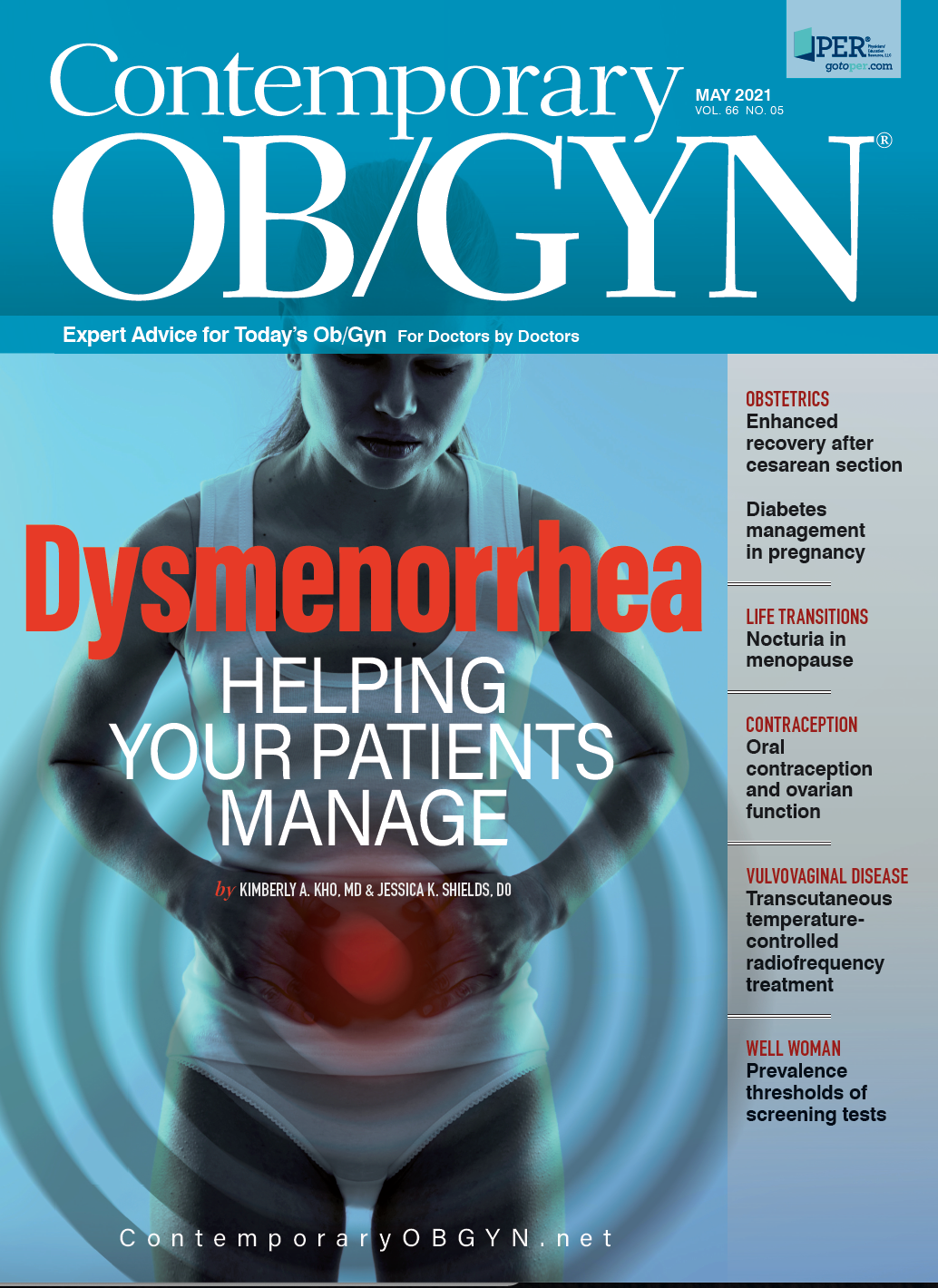
Prophylactic methylergonovine reduces blood loss in twin cesarean delivery
February 24th 2025A recent study found that administering prophylactic intramuscular methylergonovine after umbilical cord clamping significantly reduces intraoperative blood loss and hemoglobin drop in twin cesarean deliveries.
Read More
